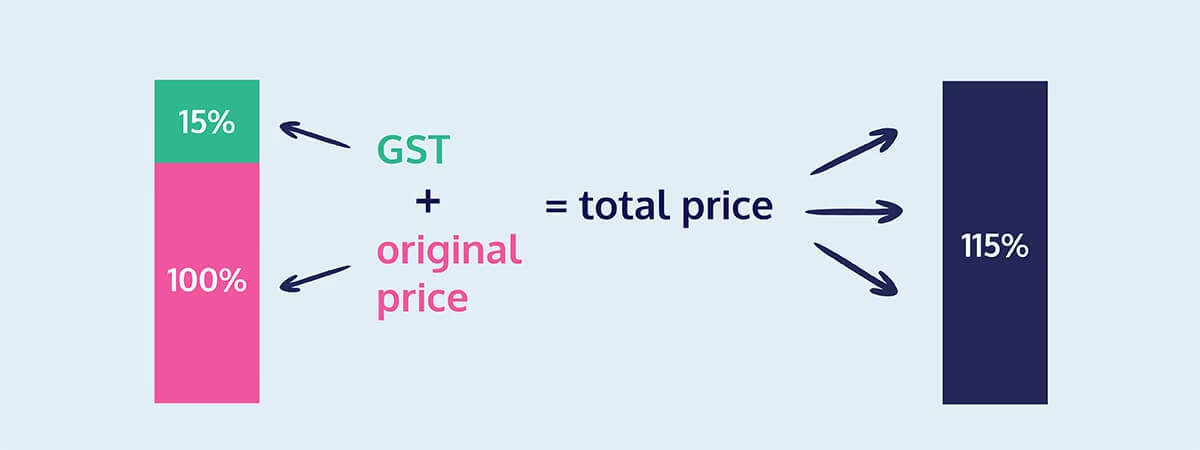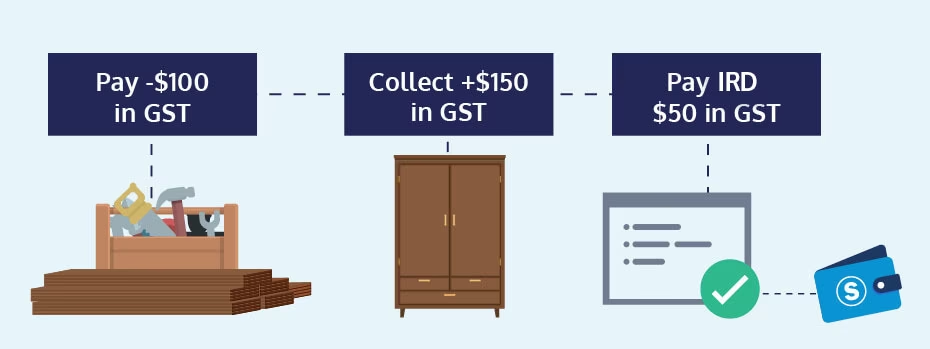As a self-employed tradie, chances are you’re at least vaguely familiar with GST. If you don’t charge it yourself, you may have noticed it on your receipts from, say, a certain large green hardware store.
But what’s it all about?
Consider this article your GST cheat sheet – we’re going to cut through the jargon, and explain everything you need to know to get the most out of GST rules.
It might look like a lot, but it’s all valuable info. If you’ve already heard some of this before, you can use this table of contents to skip to the good bits.
- Intro to GST – what’s it all about?
- Registering for GST
- Calculating, charging, and collecting GST
- Claiming business expenses vs. claiming back GST
- How Hnry makes it simple
Intro to GST – what’s it all about?
The Goods and Services Tax, or GST, is a flat-rate consumption tax of 15%, levied on most goods and services sold in Aotearoa.
Now let’s break that down:
| Flat rate | Unlike New Zealand’s [progressive income tax rates](https://hnry.co.nz/tax-resources/sole-trader-tax-rates/), GST is charged at a flat rate, meaning it doesn’t change no matter how much you earn, what you buy, or how much it costs. |
|---|---|
| 15% | The GST rate in New Zealand is fixed at 15%. |
| Consumption tax | A consumption tax is a tax added to goods and services we ‘consume’ – as in use or use up, not necessarily eat and drink. |
| Levied on most goods and services | There are some goods and services that are GST exempt. It’s a [limited list](https://www.ird.govt.nz/gst/charging-gst/exempt-supplies) though, and prooooobably doesn’t apply to you. |

GST isn’t profit kept by a company, or an additional income tax. Instead, it’s collected by businesses on behalf of the IRD. If you’re GST registered, you’re required to charge and collect GST from your clients.
The good news is that, if you are GST registered, you can then claim back any difference between the GST you charge and the GST you pay other companies as a GST credit. More on that in a bit, but first –
Registering for GST
If you’re registered for GST, you’re required to charge and collect GST. If you’re not registered for GST, you can’t charge or collect GST.
It sounds pretty obvious, but you’d be surprised how many people mess that one up!
But how do you know if you need to register for GST? Well –
Above the GST threshold:
If you’ve made $60,000 or more in self-employed income in the last 12 months, or expect to make $60,000 or more in the next 12 months, you’re required to register for GST. Simple!
Below the GST threshold:
If you’re earning below this threshold, you can decide whether or not to register for GST. There are pros and cons for doing so, though.
The main pro is that you can claim back the GST paid on your business expenses (subject to restrictions/exemptions). If you pay more in GST when buying supplies for your business than you charge your clients, you should be eligible for a GST refund of the extra credits.
If you buy a lot of supplies for your business in bulk, then being able to claim the GST back can help you better manage your cash flow. Similarly, it might make it easier to deal with your suppliers.
The main con is that it can be extra paperwork for little reward — depending on your business, getting a substantial GST return is unlikely, and potentially not worth it.
Whether or not you register for GST is up to you, but make it a calculated business decision.

GST Periods
When you register for GST, you decide how often you would like to file your GST returns. This timeframe then becomes your GST period.
There are three options you can choose from:
- Monthly
- Easier to keep track of, but involves more paperwork
- Bimonthly (every two months)
- 6-monthly (unless you earn over $500,000 a year)
- Harder to keep track of (if you don’t use Hnry), but less paperwork overall
You’ll also decide whether you’ll pay on a “payments” or an “invoices” schedule (FYI at Hnry, we work on a payments basis).
Sometimes, you may find that within a GST period, you’ve paid more in GST than you have collected. In these instances, you would receive a GST refund from the IRD.
Calculating, charging, and collecting GST
Calculating GST
To add GST to your services, divide the original price by 100, multiply that number by 15, and slap that on to the original price.
💡 Check out our handy GST calculator here
For example, for a $1,000 plumbing job, you’d need to charge $150 in GST (1,000/100 x 15 = 150).
Remember, GST is a tax for your clients to pay, not you!
Charging GST
Because you’re GST registered, you’ll need to provide your clients with “taxable supply information”, which is a little different from regular old invoices.
If a sale is for less than $200, in most situations there is usually no requirement to issue taxable supply information. You should be able to find the taxable supply information through other documentation, like credit card statements. Basically, what they’re after is:
- Your name
- The date of the invoice/sale
- A description of your goods/services
- The price of your goods/services
If a sale is between $200 and $1,000, you’re required to supply:
- Everything mentioned above, as well as
- Your GST number, and
- Clear indication that GST has been charged.
If a sale is for more than $1,000, you’ll also have to provide:
- Everything mentioned above, as well as
- The recipient’s name
- The recipient’s address, phone number, email, trading name, NZBN, OR website
Phew!
💡 Taxable supply information doesn’t have to be included in an invoice, or even with every sale – if you work repeatedly with the same client, you can give them the taxable supply information separately, or include it in your contract with them.
📖 Interested in invoicing through Hnry? We automatically keep you compliant!
Collecting GST
Any GST paid to you by your clients belongs to the IRD (unfortunately), not you! This means you should set aside this amount to pay on to the IRD.
But if you’re also paying GST as part of your business expenses, you can subtract this amount from the GST you collect for the IRD. That’s yours to keep.

You’ll need to be careful to set the right amount of GST aside, though. Failure to do so may result in fines and penalties – nasty!
The good news is that you don’t need to do these calculations yourself – join Hnry, and we’ll automatically do it all for you. Plus we give you tax relief as you go!
Claiming tax deductions vs. claiming GST
After all this, you may be wondering, why bother with this GST business if you can already claim tax deductions for your business expenses?
Well, there’s a difference in how tax deductions and GST returns work.
Firstly, tax deductions aren’t tax refunds – you won’t get a straight refund for the cost of your business expenses. Instead, the cost of your business expenses lowers your taxable income.
(If this doesn’t make sense, we go into more detail about this in our intro to tax deductions article.)
Certain GST returns, however, are an actual refund. The IRD refunds you GST if you’ve paid more in GST for your business than you’ve collected.
If you plug your numbers in and do the maths, you may see a slight difference in the amount of tax saved.
Hnry really does it all for you
And we mean all.
For just 1% +GST of your self-employed income (capped at $1,500+GST a year), we will:
- Automatically calculate and deduct your income tax
- File your tax return for you
- Automatically set aside GST payable
- File your GST returns for you
- Calculate and pay your ACC levies
- Set aside KiwiSaver contributions (optional)
- Sort out your student loan repayments
- Manage your business expenses
- Politely chase up your late-paying clients
- … and so much more!
Our job is to make sure your financial and business admin is so simple, so easy, that you never think about it again. Instead you can focus on the important things – like your actual work.
Join Hnry today!
Share on:

